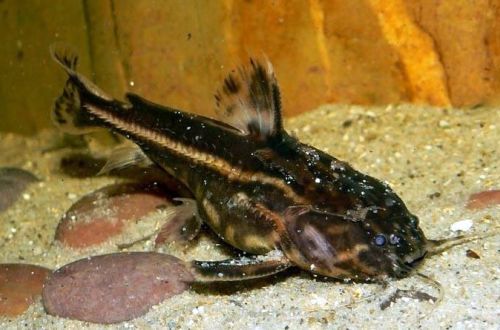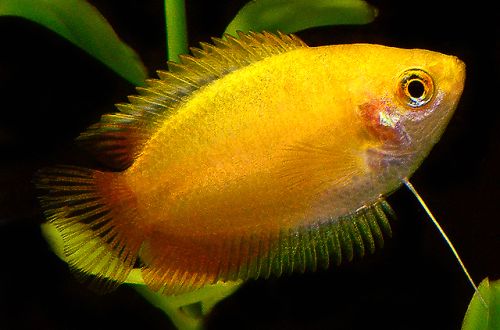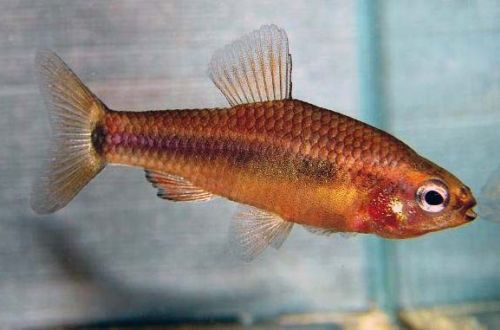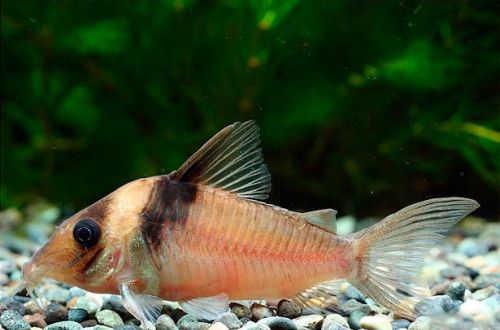
Acantodoras nga tsokolate
Acantodoras chocolate or Chocolate talking catfish, scientific name Acanthodoras cataphractus, belongs to the family Doradidae (Armored). Another common name is prickly catfish. A rare guest in a home aquarium. It is generally exported as by-catch to a consignment of related Platidoras species.

Kaundan
Habitat
Comes from South America. Inhabits numerous rivers in Guyana, Suriname and French Guiana, which flow into the Atlantic Ocean. Found in small tributaries, streams, backwaters, freshwater and brackish marshes, coastal mangroves. In the daytime, catfish hide on the bottom among snags and aquatic vegetation, and at night they swim out of their shelters in search of food.
Mubo nga impormasyon:
- Ang gidaghanon sa aquarium - gikan sa 100 ka litro.
- Temperatura – 22-28°C
- Bili pH - 6.0-7.6
- Katig-a sa tubig – 4–26 dGH
- Type sa substrate - balason
- Paglamdag - gipaubos
- Brackish water is permissible in a concentration of 15 g of salt per liter
- Ang paglihok sa tubig - gamay o wala
- Ang gidak-on sa isda hangtod sa 11 cm.
- Pagkaon - bisan unsang pagkaunlod nga pagkaon
- Temperament – malinawon
- Kontento sa usa ka grupo sa 3-4 ka indibidwal
Description
Adults reach a length of up to 11 cm. The color is brown with a light stripe along the lateral line. The fish has a massive head and a full belly. The massive first rays of the pectoral and dorsal fin are sharp spikes. The rigid body is also dotted with small spines. Sex differences are minor. Females look somewhat larger than males.
The bone plates on the head can make a sound when rubbed, so this group of catfish was called “speaking”.
Food
An omnivorous species, it will eat anything that gets into its mouth, including inattentive small fish. The home aquarium will accept most popular sinking foods in the form of flakes, pellets, supplemented with live or frozen brine shrimp, daphnia, bloodworms, etc.
Pagmentinar ug pag-atiman, kahikayan sa aquarium
The optimal size of the aquarium for a group of 3-4 fish starts from 100 liters. Spiny catfish prefers dim lighting and needs reliable shelters, which can be both natural elements (snags, thickets of plants) and decorative objects (caves, grottoes, etc.). sandy soil.
The fish are able to adapt to a wide range of hydrochemical values, including brackish water with a low salt concentration (up to 15 g per liter). Long-term maintenance is possible only in stable water conditions, sharp fluctuations in pH and dGH, temperature, as well as the accumulation of organic waste should not be allowed. Regular cleaning of the aquarium along with the placement of the necessary equipment will guarantee clean water.
Kinaiya ug Pagkaangay
Non-aggressive calm fish, preferring to be in a group of at least 3-4 individuals. Compatible with other Amazon species of medium to large size. Reliable protection will allow keeping together with some predators.
Pagpasanay / pagpasanay
At the time of writing, very little reliable information about the reproduction of Chocolate Talking Catfish has been collected. Probably, with the onset of the mating season, they form temporary male/female pairs. Caviar is laid in a pre-dug hole and the clutch is guarded during the incubation period (4–5 days). Whether care continues for the offspring that has appeared is unknown. Do not breed in home aquariums.
Mga sakit sa isda
Ang pagkaanaa sa paborableng mga kahimtang panagsa ra nga inubanan sa pagkadaot sa kahimsog sa isda. Ang panghitabo sa usa ka partikular nga sakit magpakita sa mga problema sa sulod: hugaw nga tubig, dili maayo nga kalidad nga pagkaon, mga samad, ug uban pa. Ingon sa usa ka lagda, ang pagwagtang sa hinungdan modala ngadto sa pagkaayo, bisan pa niana, usahay kinahanglan ka nga moinom og tambal. Basaha ang dugang bahin sa mga sintomas ug pagtambal sa seksyon sa Mga Sakit sa Isda sa Aquarium.





